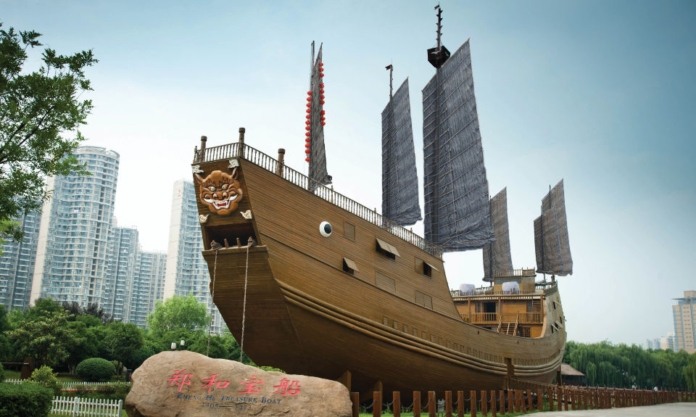Zheng He, quite possibly China’s most famous explorer, is our last stop on this journey through Nanjing Muslim history.
Born Ma He to a Muslim family in Kunming, Yunnan Province, during the Ming Dynasty, family records claim that they traced their history to settling in Xianyang (modern-day Xi’An) in Sha’anxi Province during the Song Dynasty.
Ma had four younger sisters and an older brother, the main point by which his descendants trace their lineage to today. While Ma was captured and castrated as a young teenager by Ming invaders who took over then-Mongol-ruled Yunnan, his elder brother escaped capture and remained in hiding until Ma became a high-ranked official.
After capture, Ma served the later-Yongle Emperor while he was still the Prince of Yan. It was under the then-Prince’s service that Ma gained an education in Beiping (Beijing today). This essentially gave him the tools to become an incredibly useful military commander to the future emperor.
In 1399, when the Prince of Yan rebelled against his enthroned nephew, Ma proved a loyal and useful subordinate by successfully defending the Zhenglun reservoir (for the city of Beiping) against imperial siege, and later on, in the successful capture of the capital, Nanjing. In recognition of Ma’s work, the newly-enthroned Yongle Emperor granted Ma the new surname of “Zheng”.
Zheng grew through the ranks, leading to his famous seven voyages across the seas. In nearly 30 years of voyaging, Zheng served three emperors.
According to family accounts, by the time he became sufficiently ranked, Zheng returned to his Yunnan hometown, in search of his remaining family, bringing his elder brother’s family back to Nanjing with him.
He eventually passed away overseas during his final voyage. A tombfor him was erected on today’s Niushou Mountain (牛首山), rebuilt in 1985 with Nanjing city government funds in recognition of his voyaging legacy. Today, a small museum is located next to the tomb recognising his efforts and contribution to knowledge.
Another museum is located on Changbai Jie (长白街) near the Zheng He Garden (郑和公园) outside Mafu Xincun (马府新村) neighbourhood. The reason? Prior to the destruction caused by the Taiping Rebellion, this had been land belonging to the Zheng family. Specifically, it was the area that once hosted the family’s lotus garden.
Today, the garden remains home to a 600-plus-year-old Wisteria, perhaps the last living physical object remaining that was a part of Zheng’s incredible life.
According to Mr. Zheng Zihai (a 73-year-old, 19th generation descendant) working in an office at the Zheng He Museum, this land has been in Zheng’s family hands since the Ming Dynasty, only being desecrated during the Taiping era, to be reclaimed by the government in the mid-20th century.
The physical family records or “jiapu” (家谱) were given to the government in 1957 in Beijing.
In 1983, after hearing no word on traces of the records, descendants traveled to the capital, searching loose ends for 20+ days before finding copies of pieces of the records.
Today, these are all that remain, with a copy left in Beijing’s Cultural Palace of Nationalities (民族文化宫).
When asked about what he, as a descendant, felt was the most important thing he wished to relay in regard to the legacy of Zheng He, Zihai stated, “Twelve words: (热爱祖国 睦邻友好 科学航海) Zheng He was a man who deeply loved his country, embodied diplomacy and friendly relations, and bore great knowledge of the seas”.
Zheng may be gone today, but his legacy certainly lives on, not least through the remaining museums and gardens in our beautiful city.









